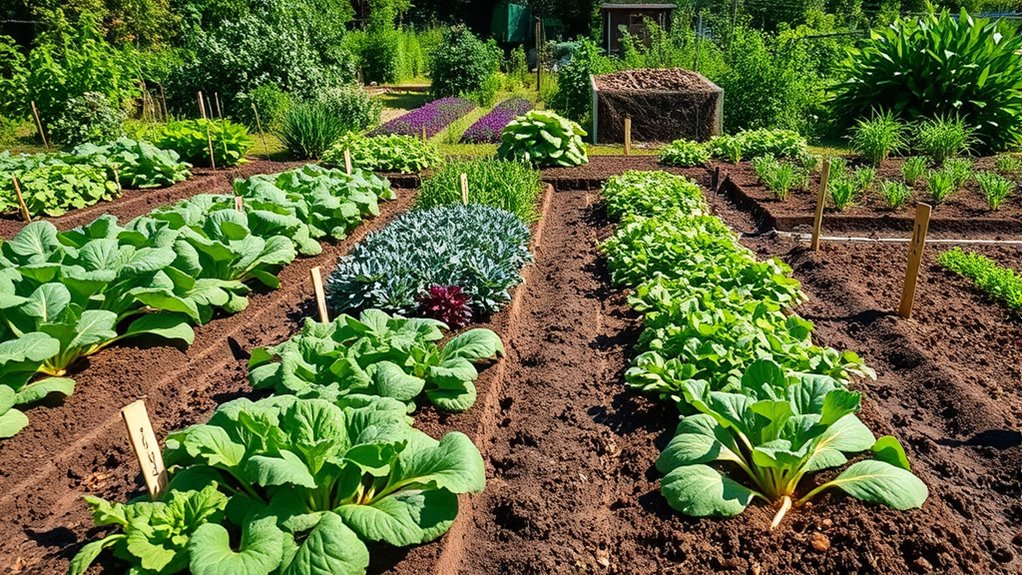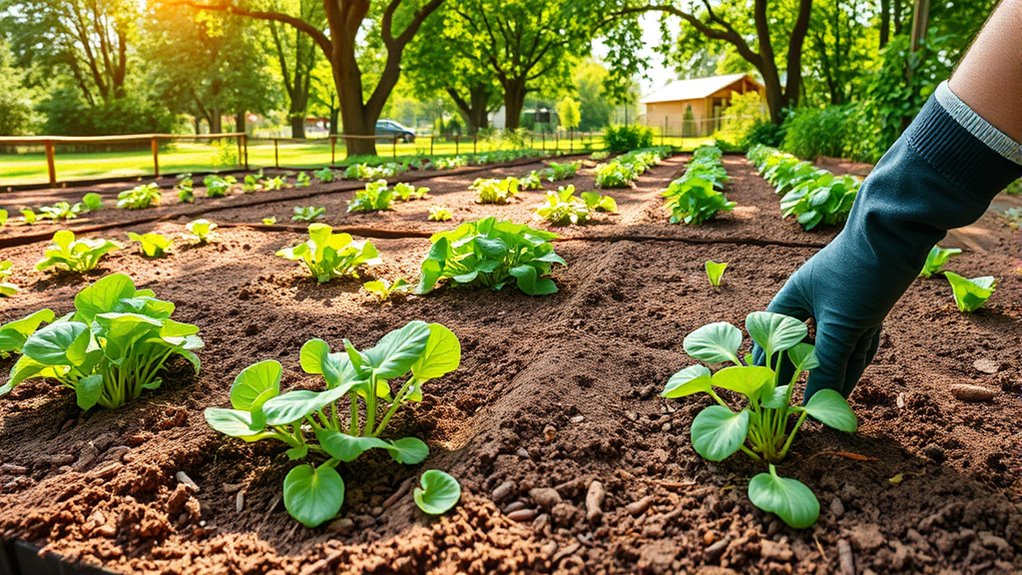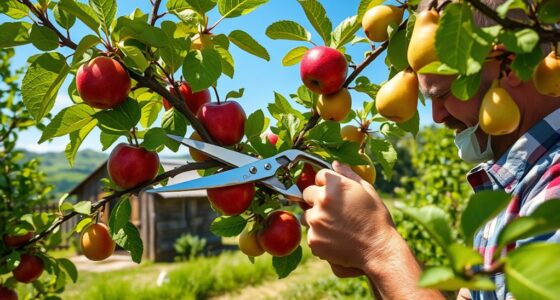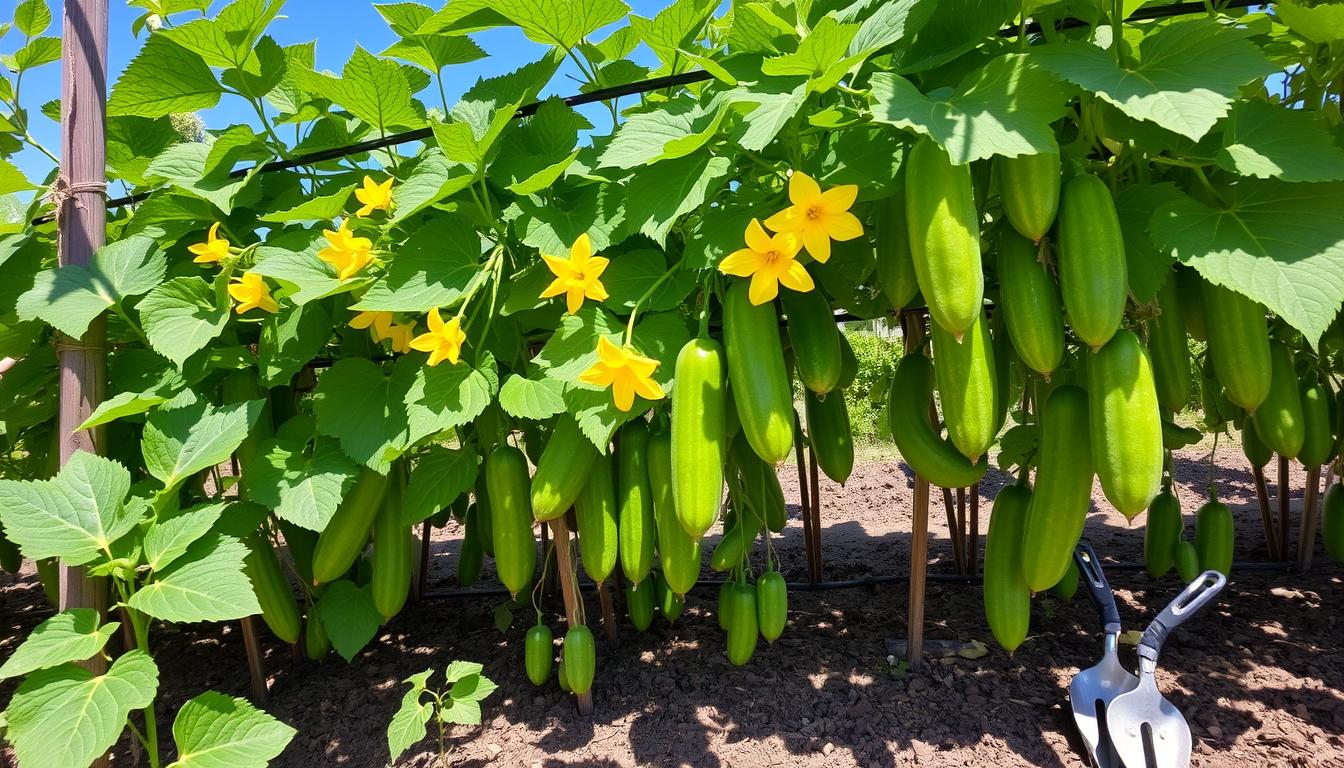To keep your soil healthy, rotate crops by changing plant types each season to prevent nutrient depletion and curb pests. Use companion planting—such as growing beans with corn—to naturally boost soil fertility. Add organic matter like compost or manure to enrich your soil, and incorporate cover crops to improve soil structure. Testing your soil helps you make tailored amendments for better results. Mastering these principles will give you practical steps to maintain a thriving garden long-term.
Key Takeaways
- Rotate plant families to prevent soil depletion and reduce pest buildup.
- Incorporate organic soil amendments like compost and manure to maintain fertility.
- Practice companion planting, such as beans with corn, to naturally fix nitrogen.
- Use soil testing to tailor amendments and ensure balanced nutrient levels.
- Diversify crops to enhance soil resilience and promote sustainable gardening.

Implementing a garden crop rotation plan is one of the most effective ways to maintain healthy soil and improve your harvest. By changing the types of plants you grow in each section of your garden from season to season, you prevent soil depletion and reduce the buildup of pests and diseases. This strategy guarantees your soil stays nutrient-rich and productive over time. To boost your crop rotation efforts, consider incorporating companion planting, which involves growing certain plants together for mutual benefit. For example, planting beans near corn can help fix nitrogen in the soil, enhancing fertility without relying solely on chemical fertilizers. This symbiotic relationship not only improves soil health but also supports the growth of both crops.
In addition, soil amendments play a pivotal role in maintaining the vitality of your soil throughout the rotation process. Organic amendments like compost, aged manure, or cover crops enrich the soil with essential nutrients and organic matter, creating an ideal environment for plant roots. When you rotate crops, it’s important to replenish nutrients that might have been depleted by previous plants. For instance, heavy feeders like tomatoes and corn extract a lot of nutrients, so after harvesting them, adding compost or other organic matter helps restore the soil’s fertility for the next crop. Incorporating crop diversity into your rotation can further enhance soil resilience and reduce pest issues, creating a more sustainable gardening system. Additionally, understanding the different plant families and their specific nutrient needs can help you plan more effective rotations and reduce the risk of soil fatigue. Using mindfulness techniques during garden planning can also help you stay focused on sustainable practices and make thoughtful decisions that benefit your soil health. Recognizing the benefits of water management can also improve overall soil conditions, especially in areas prone to drought or heavy rainfall. Moreover, being aware of soil testing can guide you in making precise amendments tailored to your soil’s specific nutrient profile.
Frequently Asked Questions
How Often Should I Rotate My Garden Crops Annually?
You should rotate your garden crops annually, ideally every planting season, to maintain soil health and nutrient balance. Changing your planting schedule helps prevent pests and diseases from building up. By rotating crops, you improve soil nutrient management, ensuring different plants utilize nutrients differently. This practice keeps the soil fertile and productive, reducing the need for chemical inputs, and supports a thriving, healthy garden year after year.
Can Crop Rotation Prevent All Soil-Borne Diseases?
Crop rotation substantially helps prevent many soil-borne diseases by disrupting pest and pathogen cycles. However, it can’t eliminate all issues, especially those caused by persistent soil pathogens or fungi. To maximize soil health, you should also focus on soil nutrient management and implement pest control strategies alongside rotation. Combining these practices creates a thorough approach, reducing disease risks and promoting healthy, productive soil for your garden.
What Are the Best Companion Plants for Crop Rotation?
Did you know interplanting strategies can reduce pest issues by up to 50%? When selecting companion plants for crop rotation, choose pest-repelling plants like marigolds, basil, and nasturtiums. These plants not only attract beneficial insects but also deter pests, enhancing soil health and crop yield. Incorporate these into your garden plan to improve pest management naturally, making your crop rotation more effective and your garden more productive.
How Do I Plan a Crop Rotation Schedule for a Small Garden?
To plan a crop rotation schedule for your small garden, start by dividing your garden beds into sections. Consider composting basics to enrich the soil each season and prepare your garden beds properly before planting. Rotate plant families, like legumes, leafy greens, and root vegetables, to prevent soil depletion. Keep a garden journal to track what you plant where, ensuring healthy soil and productive harvests year after year.
Are There Any Crops That Should Never Be Planted Consecutively?
Think of crop succession as a delicate dance—you don’t want to trip over your own feet. Some crops, like potatoes or tomatoes, shouldn’t follow each other due to crop incompatibility or disease risk. Avoid planting legumes after alliums, for example, since it hampers nitrogen fixation. By understanding plant succession and crop incompatibility, you keep your soil healthy and your garden thriving, preventing pests and diseases from taking root.
Conclusion
By rotating your crops, you help keep your soil healthy and productive. Did you know that planting the same crop in the same spot every year can decrease yields by up to 50%? So, mix it up! A simple rotation plan not only boosts your garden’s health but also prevents pests and diseases. Embrace crop rotation, and you’ll enjoy healthier plants and better harvests season after season. Your garden will thank you!










